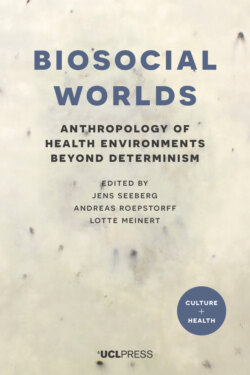Читать книгу Biosocial Worlds - Группа авторов - Страница 13
Synergies
ОглавлениеHow do conventional ways of classifying disease establish barriers to understanding the biosocial complexities that frame the workings of both disease and treatment? In her chapter on co-morbidity in Botswana, Livingston points out that biology is often assumed to be a main determinant of singular illnesses, but in situations of multiple sickness biology often points in many directions simultaneously: co-morbidities may be clearly intertwined with social, political and health systemic factors, which themselves interact at biological levels. The complex co-morbidity of TB, HIV/AIDS, and cancer can be seen as a biosocial synergy that plays itself out not only at the levels of social distribution and epidemiology of disease. It also shapes processes at the clinical level, when patients seek diagnosis and treatment in health systems whose institutional infrastructure is designed to separate disease categories into, for example, TB, HIV, or cancer. Yet, in the bodies and lives of patients these disease categories are intertwined, and this kind of synergy challenges our analytical categories and calls for reconceptualisation. Ontological certainties that distinguish one disease from the other are questioned, and how the diseases interact with each other and with social and other factors is foregrounded. Livingston gives the example of one form of cancer, Kaposi’s sarcoma, which practically does not exist in women unless they are HIV positive. So, are Kaposi’s sarcoma and HIV two diseases or one? Such matters of definition continue to be highly impacted by political, economic, moral and institutional projects that arise around specific diseases.
Whether diseases and epidemics are defined as single or multiple entities may be quite significant in cases where such definition comes to determine how health problems are addressed. If cancer is seen as intimately intertwined with and part of the HIV epidemic, this may have consequences for how funding is spent, how prevention and treatment is organised, and how patients are met in clinical contexts.
Co-morbidity, at the scale of epidemics, has been conceptualised as syndemic in response to the dominant biomedical conception of diseases as distinct entities in nature, located in specific organs, separate from other diseases and independent of the social and cultural contexts in which they are found (Singer 2009, 25). The syndemic perspective allows us to think about disease in relational rather than categorical terms, and to consider the importance of interacting social (and environmental) conditions that promote the spread of disease. In syndemics, the health effects of co-morbid conditions are not additive, but multiplicative (Singer 2009, 26).
Synergies are further explored in Meinert and Whyte’s description of the rapid spread of trauma and spirits in Northern Uganda after the civil war. The number of local healers dealing with spirit possessions grew significantly alongside an influx of NGOs and humanitarian organisations treating PTSD. The authors suggest analysing the spread as related syndemic processes of situated and concerned responses to violence, which involve local biosocial worlds, as well as humanitarian psychology. Pointing out that the behavioural symptoms of both spirits and trauma often co-exist with other problems such as alcoholism, HIV and diverse health conditions, the authors discuss how these problems are intimately intertwined, making the separation of the biological and the social untenable.
In biomedical discourse, PTSD, alcoholism and HIV are commonly described as forms of co-morbidity. Yet when these problems tend to come in the same clusters repeatedly, it should make us ask questions about the categories that make them appear as separate conditions. From a broader perspective, trauma and related problems thrive in particular social, economic and historical conditions, and their rapid spread may, indeed, be seen as syndemic (Singer 2009; Singer and Clair 2003) at the population level. Where a biomedical perspective on PTSD foregrounds the damage to the individual (biological) brain during traumatic events and regards other factors (such as alcoholism) merely as ‘triggers’ or consequences of disease, a syndemic perspective enables a synergetic view of biosocial interaction, which does not reduce or range factors and consequences as biological or social. This perspective on biosocial becoming involving many different kinds and levels of influences obviously has consequences for how health problems related to legacies of violence are dealt with.
